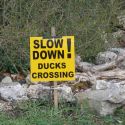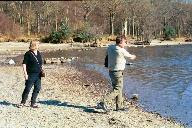The day starts with ominous spatters of rain on the window, but bits of light sky as well, and breakfast - brought in on trays. It's substantial enough - hardboiled egg, large roll, cheese triangle, apricot jam, synthetic juice (remarkably reminiscent of flat orange crush), slices of tinned peach and pre-packaged pieces of cake and chocolate croissant. Not precisely what we would have chosen to eat, but certainly more than enough. We each get a tea bag and a small packet of Nescafé as well. So we attempt to heat a small pot of water on the flat electronic burner. Looks obvious but the burner doesn't begin to heat. Turns out that the stove is smarter than we are - it won't come on until there's a pot on the burner.
Lilly and Steven arrive about eleven to meet us in the lobby. Lilly and I met online pursuing overlapping genealogical interests. We have shared (Manning) ancestry, but you have to go back to the early 1700's along the Hudson River to find it. Lilly is a Californian married to a Syrian and living in Lattakia on the northern coast. Steven, her 18 year old son is a very pleasant young man and has accompanied Lilly on the five hour bus ride from Lattakia, lured in part by the opportunity to buy DVDs.
It's lovely meeting them after years of emails, and we're lucky to have them as local guides to some of the spots we haven't visited before, Lilly filling in background information and Steven fluently reading the Arabic explanations and negotiating local prices.
We start with the tomb of the chivalrous Saladdin (literally Righteousness of the Faith - Salah ad-Din, a description rather than a given name), who recaptured the Holy Land from the Crusaders - respected opposite number to Richard the Lionheart.
Then to the Umayyad Mosque, also in the old city, considered the fourth holiest site in Islam. It was completed in 715 on the site of an earlier Christian basilica dedicated to John the Baptist, whose head is believed to be in a shrine within. For years Christians and Moslems shared the building but eventually the arrangement broke down. The buuilding itself is huge and classically proportioned (based on the temple of Jupiter which preceded the basilica - itself a replacement of an earlier temple to the old pagan god Ba'al). There's a spacious courtyard and Lilly and I don long hooded cover-up coats before entering. There is a stunning gold mosaic over the outside entrance and beautiful mosaic work and carving inside - as well as a lot of high ceilinged space and white walls giving a sense of peace. Women pray on one side and men on the other, but there are no dividing walls - just Corinthian columns.
The mosque is also a sacred place for Shi'ites as it marks the place where the head of Mohammed's grandson Hussein was previously displayed. He's regarded as a Shia martyr (long story, best googled) and many Iranians visit the site. Lilly points them out in the mosque and in the souk, recognisable by their black chadors, worn by young women as well as old. We spend some time outside the shrine of John the Baptist, all pillars and coloured glass and metal grillwork, through which can just be glimpsed a coffin-like object - much bigger than a head.
We stop for lunch at a restaurant in the old city - accessed through a long passage with ancient doors leading to houses still occupied. The restaurant is in an old house with tables in a spacious courtyard. It's a beautiful spot and Lilly and Steven explain the menu to us, describing the various Syrian dishes. Seems it's a bit like a Polish menu though. (In Poland a menu lists everything that might ever be on offer - you have to ask which of the items they actually have). So we end up with beef (J) and chicken (Lilly and me) in a tasty tomato and pepper sauce over rice. Steven orders a dish in a yoghurt sauce. All very nice and in an amazing spot. A good chance to visit as well. And the bill is interesting too - featuring not only the sour pickles and the bottle of water and packet of pitas, but also the box of tissues. A lovely experience.
After lunch we visit the Azem Palace, built in 1750 for the Ottoman governor of Damascus, and consisting of several buildings around an enormous courtyard. Steven and I estimate that one servant would have had to do nothing but sweep. It's done in limestone, sandstone, basalt and marble, giving a patterned effect, and features ceilings with painted wooden paels in rooms that have been restored to display period furnishings and costumes. Most impressive is the family baths, though we're up against closing time and a little in the way of baksheesh is required to let us stay. But Lilly is right - it is impressive, a smaller version of the public hammam with baths of different size in its various rooms and a complex water delivery system. Lilly has a friend who is a member of the Azem family. The family lived in the palace until the 1920's, and her friend's father was actually born here. Impressive to us, but L says the friend's teenage children are completely uninterested in this bit of ancient history.
We separate outside the fountained courtyard and Lilly and Steven leave to pursue more modern shopping spots. We have a brief conversation with an American woman who looks about our age. She's ordinarily resident in France but has a visa to stay in Syria for three months. She's a confirmed traveller and likes the Middle East, but backs up our perception that accommodation is expensive in Syria. She's paying 300 euros a month for a small apartment, but says it's pretty basic. Food, though, is inexpensive, and the city is interesting.
We get lost, as one ought, in the maze of the souq, and then head back to our hotel. Here we meet the owner who, Kiki has told us, stays at the Sunflower when visiting Cyprus. The theory is that we'll rest a bit and dthen find something to eat, but we lose our initiative as we relax in front of the television updates on the Libyan revolution, and settle for tea and biscuits.




